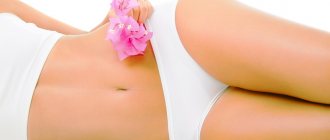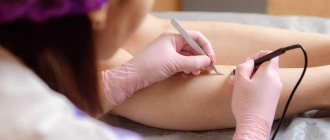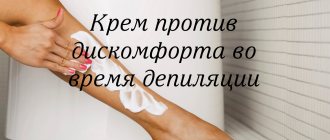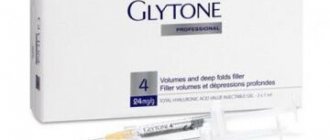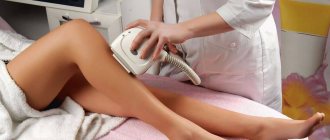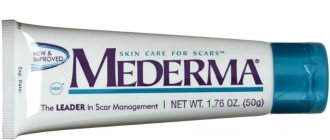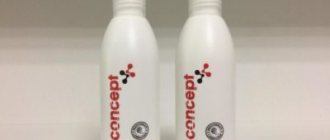Cosmetology is now developing by leaps and bounds, with new drugs and procedures appearing every year.
In this article we will look at the newfangled trend of hair removal using sugar (epilation with a sugar mixture or sugaring). We will also talk about the advantages of this procedure over similar methods. Let's compare how sugaring differs from waxing .
The difference between sugaring and waxing
The most popular, modern and more affordable methods of getting rid of hair are waxing (waxing) and sugaring; they are often compared, but there are some differences. What is the difference between sugaring and waxing? Let’s look at their differences below:
- caramel paste is made only from environmentally friendly and simple ingredients (sugar, water and lemon) in contrast to waxing, which contains paraffins and synthetic components with the addition of dyes;
- Another important aspect of how sugaring differs from wax is that sugar does not cause irritation;
- The application of the sugar mixture occurs in the direction of hair growth, and the breakdown is against the growth; when waxing, application and removal does not matter;
- the problem of ingrown hairs is more common after waxing;
- the occurrence of a burn during wax depilation in case of overheating of the liquid mass, the sugar mixture does not require heating, it is enough to knead the paste in your hands;
- The technique for sugar removal differs from wax removal in that it is painless;
- hair breaks off more often during wax depilation because... the paraffin mass hardens quickly and does not have time to capture the hair follicle at the base, leaving a hair stump;
- Sugar depilation time passes faster than with waxing;
- you can make sugar paste at home yourself (the effectiveness of the procedure will not decrease);
- Sugaring costs a little higher than waxing, but basically the difference between the services is relatively small;
- sugar residues are easily washed off with warm water, but residual material after waxing can only be removed with special oil or lotion.
Reviews
Definitely sugaring. Sugaring removes hair according to its growth, waxing does the opposite, so it is clear that sugar hair removal is less painful, and the skin afterward is soft and tender. There is no irritation, although my skin is sensitive. I removed my hair with wax, so I have something to compare with)))))
MaraCosmos
https://www.woman.ru/beauty/body/thread/4436994/ © Woman.ru
I like wax better. Sugaring is really more painful, although it doesn’t matter to me - I have a high pain threshold. But I just didn’t see the advertised beauty of sugaring. They said 100% there will be no irritation and hair will not grow in. I very rarely have 1-2 ingrown hairs from waxing, and I also had a few ingrown hairs from sugaring and there was some minor irritation. In short, I didn’t see any fundamental difference, but sugaring takes longer and the procedure itself is more expensive than waxing.
Lika
https://www.woman.ru/beauty/body/thread/4436994/ © Woman.ru
So I read the topic and understand how individual everything is! Personally, I use sugar paste. I go to the salon for hair removal) I like the procedure, it doesn’t cause any discomfort and doesn’t hurt at all. The result then makes me happy for 2 weeks))))) Waxing did not work for me, there was irritation after (((
nadejda.l
https://www.woman.ru/beauty/body/thread/4436994/ © Woman.ru
I did sugaring all the time. It lasted for a week, even though I'm blonde. Then small hairs appeared (I either used tweezers or shaved them off). Then I waited for my period, after which I did sugaring again. The hairs were growing in, I applied ichthyol ointment. Recently I accidentally tried waxing because the salon ran out of sugar. And I liked it a lot more, it didn’t hurt as much. But that's the only difference, it seemed to me. Sugaring, in principle, is not so difficult to endure.
Larisa
https://www.woman.ru/beauty/body/thread/4436994/ © Woman.ru
Each method of hair removal has its supporters and opponents. When choosing a depilation technique, women take into account the effectiveness, affordability and degree of pain of the procedure. Many cosmetologists claim that sugaring is the most in demand today. But waxing also has quite a lot of fans. The effect of both procedures lasts for a long time, and the intensity of pain depends on the individual sensitivity and professionalism of the specialist. In addition, with each subsequent procedure the pain becomes less pronounced.
- Author: woman
Rate this article:
- 5
- 4
- 3
- 2
- 1
(1 vote, average: 5 out of 5)
Share with your friends!
The principle of operation of sugaring
Sugaring (from the English Sugar - sugar) is a gentle method of depilation using a thick sugar consistency from any part of the body; sugar removes hair well along with the hair follicle, ultimately the hair falls out and temporarily stops growing. Sugar paste copes with very hard and short hairs. There are two techniques for applying and removing sugar, let’s look at their differences and compare:
- Bandage technique.
- Manual technique.
The bandage method involves removing hair using bandage strips. The principle is this: an ultra-soft or soft paste is applied to the epilated area with a wooden spatula, then a fabric strip is glued to the applied mass so that a free edge remains and then it is torn off with a sharp movement.
Manual method. Working with paste is done only with your hands without additional tools. To treat one area, one piece of sugar paste the size of a walnut is enough; cosmetologists for this technique choose a medium or thick paste depending on the temperature in the room. Many women choose manual techniques.
After epilation with sugar, new hair begins to grow after 2–4 weeks, depending on the individual characteristics of the body.
Comparison of preparation for procedures
Regardless of what has become preferable for you - waxing or sugaring, before both procedures cosmetologists prescribe recommendations for preparing the skin.
To do this, you first have an initial consultation with the specialist, during which he tells you about the intricacies of the procedure, makes sure there are no contraindications for health reasons, and prescribes recommendations for preparation.
There are a number of general recommendations that must be followed before the session:
- For a month, give up any methods of total hair removal that affect the root system of vegetation. You can only use a razor or depilatory cream to remove hair.
- A week in advance, shave the treatment area so that the hairs on it grow to the optimal length.
- For 2 days, use the scrub to eliminate dead epithelial cells, which increases the effectiveness of the procedure.
- Do not drink alcohol or energy drinks during the day, as they thin the blood.
During the session itself, the skin in the work area is cleaned, treated with a disinfectant solution of chlorhexidine, and then sprinkled with talcum powder or baby powder to increase the adhesion of wax or sugar paste to the skin.
Before using cosmetic wax, it is important to make sure that there is no allergic reaction to it, since it contains many chemical components that can cause irritation.
Before waxing particularly sensitive areas, a numbing agent is sometimes applied to the skin. It allows you to avoid pain when removing unwanted vegetation from the body. Sugaring in most cases does not cause pain.
Pros and cons of sugar hair removal
Shugaring, like any type of hair removal, has its comparative advantages and disadvantages. Its popularity over other types of hair removal lies in the fact that:
Advantages of sugar depilation:
- Natural product.
- Affordable price.
- Pain sensations are minimized.
- Can be done at home.
- Long lasting effect.
- Hypoallergenic.
- No ingrown hairs
- When pulled out, the hairs do not break off, but are removed from the roots.
- Shugaring - spa skin care, including light peeling, delicately removes dead skin cells of the epidermis.
Disadvantages of hair removal using sugar:
- Without certain skills, it will be difficult for a beginner to manipulate sugar.
- If the paste is torn off, hematomas may occur.
- Duration of the procedure.
- You need to grow your hair.
- There are contraindications for this procedure.
Which method is less painful?
Many women choosing between sugaring and waxing are interested not only in the effectiveness of both procedures, but also in their pain. Sugaring is a less painful method of depilation. This is due to the fact that sugar paste is more plastic than wax and envelops every hair. It is removed in the direction of growth, so the hairs can be removed from the bulbs without difficulty. When waxing, you have to pull the hair against its growth, which is more painful.
But do not forget that different people have different pain perception thresholds. For one, sugaring will seem unbearably painful, while for another, waxing will be tolerated calmly. In addition, the perception of pain is influenced by many factors: the temperature of the material used, the ambient temperature, state of health, mood, phase of the menstrual cycle, time of day, use of medications that affect the perception of pain (antidepressants, tranquilizers). Depending on these factors, the perception of pain by the same person can vary significantly.
The principle of waxing
Waxing (waxing) is an effective cosmetic procedure for removing unnecessary hair along with the hair follicle using a molten mixture, which before application is heated in a wax melter or using hands, depending on the type. There are different types of wax:
- Warm is most often produced in cartridges with a ball dispenser, which easily distributes the wax mass over the skin. They tear it off with bandage strips. Before use, warm up to body temperature in a microwave oven. This wax is used to treat the area of the arms, legs and armpits, where the hair is softer. It does not effectively deal with hairs in intimate areas.
- Hot is more effective because high temperature conditions open the pores and hair is easier to remove. The hot composition is preheated in a wax melter to a high temperature, after which the melted composition is applied to the treated area using a spatula, and removed with a bandage strip. Hot wax is ideal for the bikini area.
- Film is well used at home, does not require specific skills and can be used by anyone. Produced in the form of granules that are easily melted in a wax melter. The melted mass becomes like an elastic film, the film composition is applied to a small area, after 10 seconds the composition hardens and is torn off with a sharp movement of the hands. Film is convenient to use on uneven surfaces in the armpit, under the knee and in the intimate area.
- Cold is available in the form of ready-made strips on which wax is applied. Before gluing, rub the composition in your hands to warm it up a little. This method is suitable for soft hairs in the facial area.
The temperature at which the wax is heated depends on the area being epilated - the legs are treated with cold or warm wax, and the intimate area is treated with hot wax. The heated wax is applied in an even layer to the area to be epilated and after a few seconds, when the mass hardens, it is removed along with the unwanted vegetation. You can remove the composition in several ways: using your hands or bandages.
Attention! If the wax mass overheats, you can get a skin burn. Observe the heating temperature.
Comparison by main criteria
Several basic criteria can be identified that will allow for a comparative analysis to understand how sugaring differs from waxing.
Soreness
Unpleasant sensations are present both during waxing and sugaring, since the hairs are removed from the roots. But sugaring is considered less painful, since the paste is not pulled off against hair growth, but along the way. This simplifies the hair removal process and minimizes discomfort - some specialists perform the procedure so skillfully that clients do not feel anything. Another reason for the relative painlessness of sugaring is the treatment of the area in small areas. In waxing, the hair is torn off in a whole layer at once, which causes pain. Plus in the “karma” of sugar hair removal.
Quality of funds
Pastes used in sugaring are positioned as absolutely safe and hypoallergenic. In theory, besides water, sugar and citric acid, they should not contain anything else, not even preservatives - their function is performed by glucose in the composition. Accordingly, high-quality products do not cause allergic reactions or individual intolerance. Wax is characterized by a more “chemical” composition - it contains plasticizers, rosin, ethylene, glyceryl and sulfur. Although many manufacturers add caring components to the mixture - essential oils and plant extracts. Again, the benefits of sugaring due to naturalness.
Safety of use
This refers to the process of applying hair removal products to the skin. Sugar paste is used warm, heated to a temperature not exceeding 40 °C. Lubricating the skin does not cause discomfort and at this temperature cannot cause a burn. The most popular hot wax is heated to 50–65 °C, so the risk of getting burned is higher. To be fair, it is worth saying that both paste and wax can be overheated and cause burns. Home-cooked pasta is especially dangerous - many people simply don’t wait for it to cool down and use the paste too hot. Both products will be safe only if the heating temperature is maintained.
Session duration
Sugaring removes hair in small sections. Craftsmen most often use a manual technique, in which the paste is picked manually. When treating large areas, the session can last up to one and a half hours. When waxing, a large area is treated at once, which allows you to speed up the procedure. A session with an experienced master takes about 15-20 minutes. Speed benefits of waxing.
Efficiency
Hot wax grabs hairs more reliably than sugar paste, so the quality of hair removal during waxing is higher. The only exception is cold film wax, which both masters and their clients often complain about. The stickiness of the sugar paste is not always enough to remove all vegetation in one go. The paste must be applied to one area several times to keep the skin clean. Plus sign in wax karma.
Effect duration
Both hair removal methods involve removing hair along with the follicles. It takes 3 to 6 weeks for growth to recover and new hairs to begin to emerge. Much depends on individual indicators of hair growth rate, hair removal area, time of year and hormonal levels. Sugaring and waxing are equivalent.
Session cost
The prices for waxing and sugaring in salons are not much different. Masters use only professional products, which by definition cannot be cheap, so you won’t be able to save money. The cost is set for individual zones, and hair removal for men is more expensive due to the increased thickness and stiffness of the hair. The price will depend on the prestige and location of the salon (it is always more expensive in the capitals). The techniques are equivalent.
Cost of funds
If we talk about store-bought products, then wax and sugar paste are in the same price segment. But sugar is used more economically - with one piece of paste it is possible to treat a fairly large area until the caramel becomes clogged with hairs. Re-applying wax will not work - it needs replacement. You can radically reduce the cost of sugaring at home if you cook the paste yourself. Sugar, water and lemon - nothing else is needed. You can save on sugaring if you make homemade caramel.
Skin cleansing
Caramel and wax are quite sticky in structure. But the sugar paste is water-based, so after the session it can be easily removed from the skin with a regular damp cloth. Cleaning wax from skin is much more difficult due to the presence of fat and oils in the composition. And if the drops get on your clothes, it will be even more trouble. Sugaring has the advantage of being hygienic.
Contraindications
Contraindications to waxing and sugaring are identical:
- early stages of pregnancy;
- severe stages of varicose veins;
- damage, inflammation, moles on the skin;
- neurological disorders (epilepsy, psychosis);
- diabetes;
- bleeding disorders;
- autoimmune pathologies;
- taking potent and hormonal medications;
- allergy to components of cosmetic products.
The procedures are equivalent in terms of health.
Ingrown hairs
The appearance of ingrown hairs is more typical with wax, since they are removed against the growth direction. Hair follicles become twisted and may subsequently grow abnormally, becoming lodged under the skin. During sugar hair removal, the roots are not deformed and the direction of hair growth does not change, which reduces the risk of ingrown hairs. But individual characteristics and protocol violations can provoke the appearance of ingrown hairs even with sugaring. With sugar hair removal, there is less risk of ingrown hairs.
Traumaticity
Injuries include the appearance of bruises, bruises and bloody dew on the skin. Complications are possible both with sugaring and waxing, but only if the hair removal technique is broken: the skin is not properly stretched, paste (wax) is applied and removed. Neither sugaring nor waxing can be called absolutely safe.
Epilation zones
Waxing is fastest and most convenient on large areas - arms, legs, back, stomach. But sugaring is ideal for treating small and sensitive areas - the face, armpits, bikini area and deep bikini. Sugar has a gentle effect on delicate skin and allows for more subtle processing. Sugar is good for small sensitive areas, wax for large ones.
Advantages and disadvantages of wax
Regardless of the type of wax (hot, warm or cold), there are a number of advantages and disadvantages that distinguish wax hair removal from other manipulations:
- Long-term results.
- Affordable price.
- Captures the maximum number of hairs in one application.
- Fast completion of the procedure.
- Easy to use at home.
Disadvantages of waxing:
- It is not possible to remove short hairs; the minimum length is 5 mm.
- Maximum length 7 mm. if the length is not respected, hair removal will be much more painful;
- Painful sensations.
- Irritation may occur on the area being epilated, which will lead to discomfort and unpleasant pain;
- The occurrence of ingrown hairs.
- There is a risk of burns if the wax overheats.
Let's sum it up
What is the difference and differences between waxing and sugaring is now clear. It's time to summarize the step-by-step comparison.
How are the techniques similar to each other?
Sugaring and wax cannot be called twin brothers, but there are a number of similarities :
- hair is removed along with the roots, which provides a prolonged smoothness effect (up to two months);
- hair length before the procedure should be 3-7 mm;
- With regular hair removal, hair becomes thinner, lighter, grows more slowly and less frequently;
- suitable for home use;
- require similar consumables - care products, bandages, spatulas and gloves;
- have general contraindications;
- can cause injuries and ingrown hairs;
- caring components nourish and moisturize the skin, act as peeling;
- require the same preparation and skin treatment before and after hair removal.
Advantages and disadvantages of procedures: table
| Procedure | Sugaring | Waxing |
| Advantages | hypoallergenic paste; minimal pain; no risk of burns; minimal risk of ingrown hairs; You can cook the pasta yourself; suitable for sensitive skin and delicate areas; sugar is easily washed off the skin; less product consumption | high speed of hair removal; fast processing of large areas; removes hair of any density and structure the first time |
| Flaws | low execution speed; Single hairs may remain | the presence of synthetic components in the wax; painful procedure; ineffectiveness of cold waxing; high risks of ingrown hairs; risk of burns; labor-intensive rinsing of wax from skin |
As you can see from the table, sugaring has more advantages than disadvantages, which cannot be said about waxing. But the hair removal procedure is so delicate and individual that conclusions can only be drawn after testing both techniques.
Comparison: which hurts more: waxing or sugaring
Pain from waxing or sugaring depends on the sensitivity threshold. But based on numerous reviews, we can conclude that sugaring is a less painful and better-quality procedure than waxing.
When waxing, the skin can be easily injured because... wax removes hairs along with particles of the skin, and if you epilate one area several times, pain occurs with further irritation, and when sugaring, caramel paste clings only to the hair, without exposing the skin to injury.
Another important point why wax hair removal is more painful is that the wax mass is applied to a large area of skin, and the sugar paste is applied to a small area. Therefore, many people opt for sugaring, especially when they plan to epilate a sensitive area.
Composition of funds
waxing service appeared in beauty salons before sugaring. To carry it out, a product is used, which includes:
- vegetable or synthetic wax,
- rosin,
- glyceryl rosinate,
- ethylene,
- titanium dioxide.
Products with natural ingredients often cause individual intolerance, so synthetic waxes are more suitable for allergy sufferers. Some waxing products contain a cream base, essential oils, fragrances and dyes.
The composition of sugar paste for sugaring is more transparent and not so scary. It always includes 3 mandatory components:
- sugar,
- lemon juice (citric acid),
- glycerol.
Water is added in different proportions to obtain a product of a different density. Additionally, the formula is enriched with essential oils, food coloring or fragrances are added. Sugar paste has an organic composition, but in rare cases it can cause allergies.
Comparison: which is more effective: wax or sugaring?
What works better for excess hair: sugaring or waxing? Let's look at this question in more detail. The fact is that the wax removes the hairs along with the bulb, but it does not firmly grasp everything and when removed, it leaves the hairs in a broken state; tweezers will help to deal with the stump. Unlike waxing, sugar hair removal gently envelops each hair and pulls it out along with the root follicle. With regular use, the hair becomes thinner and lighter, the skin becomes smooth and velvety. We can conclude that the effect will be better from sugaring than from waxing.
But it’s definitely up to you to decide whether sugaring or waxing is better, although both techniques are harmless to the body.
Which is faster?
Now we need to figure out how wax differs from sugaring. In terms of the procedure, waxing will take less time .
Professional waxing can be done faster and more effectively in a salon by a cosmetologist than you can do yourself at home using sugar hair removal.
Both waxing and sugaring require less time if you perform these procedures frequently. The more often you do sugaring or waxing, the better and faster the next session will be .
Waxing will take 60 to 90 minutes, while sugaring will take a little longer.
Waxing does not take much time, and also does not require long cleaning of the body from caramel after the procedure.
Skin care after waxing and sugaring
After the procedures, ingrown hairs, slight irritation or redness of the skin may occur. To avoid negative consequences, cosmetologists recommend following several skin care rules:
- after manipulation, the skin must be treated with a moisturizing and restoring agent, without ethyl sprit;
- in the first days it is not recommended to visit swimming pools, hot tubs or saunas;
- It is prohibited to rub the epilated area with a washcloth and scrub, especially in the bikini area, otherwise dermatitis will occur;
- for 3 days, cover the area from sunlight and apply sunscreen with maximum protection;
- In case of a burn after waxing, treat the skin with healing ointments Panthenol or Bepanten.
- A few days after depilation, you need to do scrubbing, which will help prevent ingrown hairs and improve the condition of the cells.
What are the side effects and consequences?
When doing waxing or sugaring, it is important to pay attention to all contraindications and precautions prescribed by the cosmetologist. Despite the relative safety of the procedures, neglecting the advice of a specialist can lead to quite serious consequences.
Since both techniques mechanically remove unwanted hair from the body while targeting the hair follicles, they may cause minor dermal irritation. It is accompanied by the following signs:
- Redness.
- The appearance of red dots.
- Itching.
- Slight local swelling is possible.
Such side effects, reflecting a skin reaction, most often disappear spontaneously within 1-2 hours after hair removal, without causing the girl much discomfort. If the reaction does not go away, monitor the condition and, if necessary, consult a cosmetologist.
Sometimes, after the procedure, more serious undesirable consequences may occur due to improper implementation or failure to follow the specialist’s recommendations:
- Ingrown hairs.
- Peeling.
- Dry skin.
- Burns (when performing hot waxing).
- Bruises, hematomas and bruises.
If you notice such symptoms, you should immediately tell your cosmetologist so that he can prescribe additional recommendations for you to quickly restore your skin.
An allergic reaction may also occur after the procedure. It can be either harmless (small local inflammation that gradually subsides) or have quite dangerous consequences that affect your general health. In this case, you should immediately consult a doctor to avoid complications.
In any case, if you choose the right salon and follow all contraindications and precautions prescribed by the cosmetologist, the technique will be safe for you and will not leave any side effects.
Contraindications
Both procedures have common contraindications. Waxing and sugaring are not suitable for everyone. Hair removal data is contraindicated in the following cases:
- allergy to sugar;
- phlebeurysm;
- chronic dermatological skin diseases;
- diabetes;
- thrombophlebitis in the intimate area;
- the presence of warts, moles in the affected area;
- mechanical damage to the skin;
- irritation;
- tumors of various types and neoplasms on the skin;
- viral and infectious diseases;
- bacterial and fungal diseases;
- epilepsy.
- infectious diseases of the genital tract;
- sexually transmitted diseases (gonorrhea, syphilis, trichomoniasis, etc.);
- infections of the genitourinary organs (chlamydia, mycoplasmosis, ureaplasmosis, gardnerellosis, genital herpes, candidiasis, human papillomavirus, etc.).
